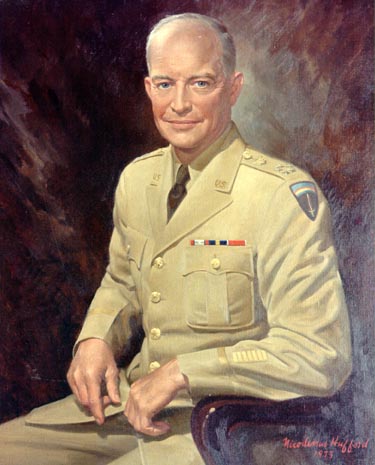
Dwight David Eisenhower was born in Denison, Texas, on 14 October 1890; graduated from the United States Military Academy, 1915; was commissioned a second lieutenant and served with the 19th Infantry, 1915–1917; married Mamie Geneva Doud, 1916; was promoted to first lieutenant, July 1916, and to captain, May 1917; served successively with the 57th Infantry and as instructor in officer courses at Forts Oglethorpe and Leavenworth, 1917–1918; commanded the Tank Corps at Camp Colt and served with it at several posts, 1918–1919; was promoted to temporary major (June) and lieutenant colonel (October), 1918; commanded the Heavy Tank Brigade at Camp Meade, 1919–1920; reverted to grade of captain (June) and advanced to major (July), 1920; graduated from the Infantry Tank School at Camp Meade, 1921, and commanded the 301st Tank Battalion, 1921–1922; was executive officer of the 20th Infantry Battalion, Panama Canal Zone, 1922–1924; again reverted to grade of captain, November 1922, and was again promoted to major, August 1924; graduated from the Command and General Staff School at Fort Leavenworth, 1926, and the Army War College, 1928; served in the Office of the Assistant Secretary of War and attended the Army Industrial College, 1929–1933; served in the Office of the Chief of Staff as aide to General Douglas MacArthur, 1933–1935; was a military adviser to the Philippine government under MacArthur, 1935–1939; was promoted to lieutenant colonel, July 1936; was executive officer of the 15th Infantry at Fort Ord, and successively chief of staff of the 3d Division, IX Corps, and Third Army, 1940–1942; received temporary promotions to colonel (March 1941), brigadier general (September 1941), major general (March 1942), and lieutenant general (July 1942); was chief of the War Plans Division and assistant chief of staff of the Operations Division, 1942; was designated commanding general, European Theater of Operations, June 1942; commanded American forces in North African landings and was designated commander in chief for Allied operations in North Africa, Sicily, and Italy, 1942–1943; was promoted to temporary general, February 1943, temporary General of the Army, December 1944, and permanent General of the Army, April 1946, with rank from December 1944; was Supreme Commander of the Allied Expeditionary Forces in Western European operations that led to Nazi Germany’s defeat, 1944–1945; was military governor of the United States Occupation Zone of Germany, 1945; was chief of staff of the United States Army, 19 November 1945–7 February 1948; presided over postwar demobilization, spoke out against excessive reduction of the armed forces, supported unification of the services, stressed the importance of research and development, and carried out a reorganization of the Army that decentralized functions; retired from active service to become president of Columbia University, 1948–1950; was recalled to active duty to be Supreme Allied Commander, North Atlantic Treaty Organization, 1950–1952; was president of the United States, 20 January 1953–20 January 1961; was reappointed General of the Army, March 1961; died in Washington, D.C., on 28 March 1969.
The Artist
Nicodemus Hufford (1915–) painted Dwight Eisenhower’s portrait for the Army some four years after the death of the former chief of staff and thirty-fourth president of the United States. Thus it was necessary for him to work, as in the case of his portrait of General Peyton C. March, from photographic likenesses. The artist was no stranger to the military subject area, for he served in the Army during World War II and spent two years in the art section at Fort Knox, Kentucky, applying his special talents to the field of training literature.
Dwight David Eisenhower
By Nicodemus David Hufford
Oil on canvas, 38" x 30",
1973
[122]
